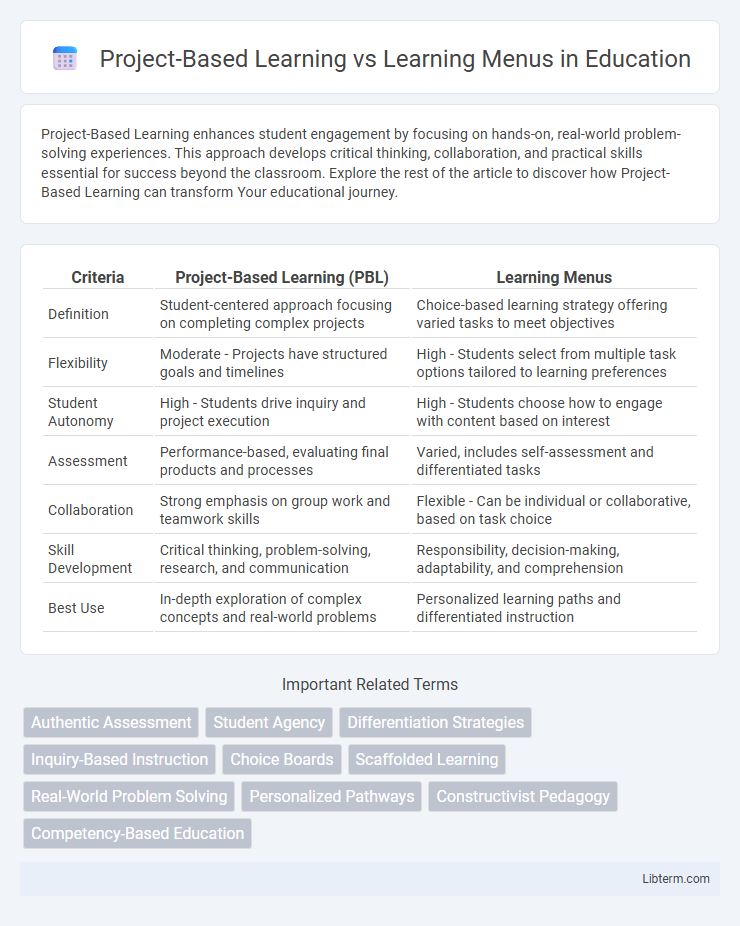Project-Based Learning enhances student engagement by focusing on hands-on, real-world problem-solving experiences. This approach develops critical thinking, collaboration, and practical skills essential for success beyond the classroom. Explore the rest of the article to discover how Project-Based Learning can transform Your educational journey.
Table of Comparison
| Criteria | Project-Based Learning (PBL) | Learning Menus |
|---|---|---|
| Definition | Student-centered approach focusing on completing complex projects | Choice-based learning strategy offering varied tasks to meet objectives |
| Flexibility | Moderate - Projects have structured goals and timelines | High - Students select from multiple task options tailored to learning preferences |
| Student Autonomy | High - Students drive inquiry and project execution | High - Students choose how to engage with content based on interest |
| Assessment | Performance-based, evaluating final products and processes | Varied, includes self-assessment and differentiated tasks |
| Collaboration | Strong emphasis on group work and teamwork skills | Flexible - Can be individual or collaborative, based on task choice |
| Skill Development | Critical thinking, problem-solving, research, and communication | Responsibility, decision-making, adaptability, and comprehension |
| Best Use | In-depth exploration of complex concepts and real-world problems | Personalized learning paths and differentiated instruction |
Understanding Project-Based Learning
Project-Based Learning (PBL) emphasizes student engagement through real-world projects that develop critical thinking, collaboration, and problem-solving skills by applying knowledge contextually over extended periods. It fosters deeper understanding by encouraging inquiry, research, and reflection, allowing students to construct meaningful connections between content and practical application. Unlike Learning Menus, which offer choice and differentiation through structured assignments, PBL centers on active exploration and authentic tasks that culminate in tangible outcomes or presentations.
What Are Learning Menus?
Learning menus are customized educational tools that offer students a variety of task options to choose from, promoting autonomy and catering to diverse learning styles. These menus typically include differentiated activities categorized by difficulty or skill type, allowing learners to select assignments that match their interests and abilities. Unlike project-based learning, which centers around in-depth exploration of a single theme or problem, learning menus provide flexible pathways to achieve learning objectives through multiple, manageable choices.
Core Principles of PBL and Learning Menus
Project-Based Learning (PBL) centers on student-driven inquiry, real-world problem-solving, and collaborative exploration to build deep understanding and critical thinking skills. Learning Menus provide structured choice through tiered tasks or activities, allowing students to select assignments that match their learning preferences and readiness levels, promoting personalized learning paths. Core principles of PBL include sustained inquiry, authenticity, and reflection, while Learning Menus emphasize differentiation, autonomy, and flexible pacing to enhance engagement and mastery.
Comparing Student Engagement
Project-Based Learning (PBL) engages students by immersing them in real-world problems requiring collaboration, creativity, and critical thinking, which fosters deeper cognitive involvement. Learning Menus offer structured choices that cater to diverse learning styles, enhancing autonomy and motivation but may lack the immersive depth found in PBL. Studies indicate that PBL typically results in higher sustained engagement due to its dynamic, hands-on nature, whereas Learning Menus excel in providing personalized learning paths that maintain steady interest.
Differentiation and Personalization
Project-Based Learning (PBL) promotes differentiation by engaging students in complex, real-world tasks that cater to diverse learning styles and encourage collaboration, critical thinking, and creativity. Learning Menus offer personalization through structured choices, allowing students to select activities that align with their interests, readiness levels, and learning preferences, which supports self-paced and autonomous learning. Both strategies enhance student engagement and mastery by addressing individual needs, with PBL emphasizing experiential application and Learning Menus focusing on customizable pathways.
Assessment Strategies in PBL vs Learning Menus
Assessment strategies in Project-Based Learning (PBL) emphasize performance-based evaluations such as presentations, project portfolios, and reflective journals that capture collaboration and real-world problem-solving skills. Learning Menus assessments focus on student choice and differentiation, using checklists, rubrics, and formative quizzes tailored to individual task selections within the menu. While PBL assessment highlights holistic and integrative understanding, Learning Menus prioritize ongoing feedback and self-paced mastery aligned with diverse learner preferences.
Real-World Application Opportunities
Project-Based Learning immerses students in complex, real-world challenges that require critical thinking, collaboration, and practical problem-solving, thereby enhancing skills directly applicable to workplace scenarios. Learning Menus offer customizable assignment options that encourage student choice and autonomy while still connecting tasks to authentic contexts, allowing learners to engage with real-world applications at their own pace. Both strategies facilitate experiential learning, but Project-Based Learning typically provides deeper, integrative opportunities for students to tackle multifaceted problems mirroring professional environments.
Teacher Roles and Responsibilities
In Project-Based Learning, teachers act as facilitators by guiding inquiry, providing resources, and assessing student progress throughout extended projects. Learning Menus require teachers to design diverse, choice-driven activities that cater to different learning styles while monitoring student selection and mastery of content. Both approaches demand teachers to balance direction and autonomy, adapting instructional strategies to support student engagement and personalized learning paths.
Common Challenges and Solutions
Project-Based Learning often faces challenges such as time management, resource limitations, and varying student engagement levels, which can be mitigated by clear project guidelines, scaffolded support, and differentiated instruction. Learning Menus challenge teachers to design diverse, student-centered options that cater to multiple learning styles, address differing skill levels, and maintain curriculum alignment; solutions include utilizing technology tools for customization, implementing formative assessments, and fostering student choice within structured frameworks. Both approaches benefit from continuous feedback loops, collaborative planning, and professional development to effectively navigate common obstacles and enhance student outcomes.
Choosing the Right Approach for Your Classroom
Project-Based Learning fosters deep engagement through hands-on, real-world problem-solving activities that develop collaboration and critical thinking skills, making it ideal for classrooms aiming to boost creativity and practical application. Learning Menus offer personalized, choice-driven tasks that cater to diverse learning styles and paces, providing flexibility and autonomy for students who benefit from self-directed learning environments. Selecting the right approach depends on classroom goals, student needs, and the desired balance between structured guidance and independent exploration.
Project-Based Learning Infographic

 libterm.com
libterm.com